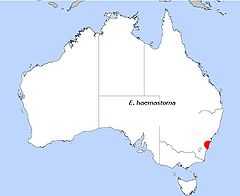Eucalyptus haemastoma
| Scribbly gum | |
|---|---|
 | |
| Scientific classification | |
| Kingdom: | Plantae |
| (unranked): | Angiosperms |
| (unranked): | Eudicots |
| (unranked): | Rosids |
| Order: | Myrtales |
| Family: | Myrtaceae |
| Genus: | Eucalyptus |
| Species: | E. haemastoma |
| Binomial name | |
| Eucalyptus haemastoma Sm. | |
 | |
| E. haemastoma, field distribution | |
Scribbly gum (Eucalyptus haemastoma) is an Australian eucalypt that is named after the 'scribbles' on its bark. These zigzag tracks are tunnels made by the larvae of the Scribbly Gum Moth (Ogmograptis scribula) and follow the insect's life cycle. Eggs are laid between layers of old and new bark. The larvae burrow into the new bark and, as the old bark falls away, the trails are revealed. The diameters of the tunnels increase as the larvae grow, and the ends of the tracks are where the larvae stopped to pupate.
Eucalyptus haemastoma is a small to medium sized tree (or occasionally a mallee). The bark is smooth, white/grey. Juvenile leaves are stalked, ovate or broadly curved and oblique to 22 x 8 cm, pendulous and blue-green. The adult leaves are stalked, broad lanceolate or curved to 15 x 3 cm, concolourous, glossy green. White flowers appear in late spring to early summer. Capsules are pear-shaped, to about 8 mm diameter, with usually 4 enclosed valves. Distribution is restricted to the coastal plains and hills in the Sydney Region.[1]
See also
References
- ↑ Brooker, I., Eucalyptus, Illustrated guide to identification, Reed Books, Melbourne, 1996
| Wikimedia Commons has media related to Eucalyptus haemastoma. |